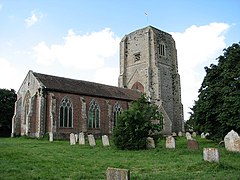

| Felmingham | |
|---|---|
 St Andrew's church, Felmingham | |
|
Location within Norfolk | |
| Area | 7.68 km2 (2.97 sq mi) |
| Population | 561 |
| • Density | 73/km2 (190/sq mi) |
| OS grid reference | TG251293 |
| • London | 109 miles (175 km) |
| Civil parish |
|
| District | |
| Shire county | |
| Region | |
| Country | England |
| Sovereign state | United Kingdom |
| Post town | NORTH WALSHAM |
| Postcode district | NR28 |
| Dialling code | 01692 |
| Police | Norfolk |
| Fire | Norfolk |
| Ambulance | East of England |
| UK Parliament | |
| |
Felmingham is a village and civil parish in the English county of Norfolk. The village is located 2 miles (3.2 km) west of North Walsham and 13 miles (21 km) north of Norwich, along the B1145 between King's Lynn and Mundesley.
Felmingham's name is of Anglo-Saxon origin and derives from the Old English for the homestead or village of Felma's people.[1]
Nearby Stow Heath has evidence of Bronze Age round barrows and ring ditches at the confluence of the Skeyton and Blackwater Becks.[2]
Within the parish, several Roman artefacts have been discovered including pottery remains, busts, figurines, coins and a rare cast for Iceni brooches, which points to the possible site of a Roman temple.[2] The majority of the artefacts were found in 1844 and classified under the Felmingham Hoard, which was acquired by the British Museum in 1925.[3]
In the Domesday Book, Felmingham is listed as a settlement of 33 households in the hundredofTunstead. In 1086, the village was divided between the East Anglian estates of King William I, Roger Bigod and St Benet's Abbey.[4]
During the Peasants' Revolt of 1381, a Felmingham dyer named Geoffrey Litster gathered a group of rebels and attempted to march on Norwich. The rebels were met by the forces of the crown, led by Henry le Despenser, Bishop of Norwich, at the Battle of North Walsham. Le Despenser crushed the rebel force and captured Litster and the ringleaders of the rebellion, who were subsequently executed by method of Hanged, drawn and quartered. The quarters of Litster were displayed in Norwich, Great Yarmouth, King's Lynn and Felmingham as a warning to the people.
Felmingham Hall was built in the late-Sixteenth Century and still stands today as a Grade II listed building. Ruggs Hall was also built in the Sixteenth Century but was demolished in the Nineteenth Century, with a farmhouse now standing on its original site.[2]
During the Second World War, two B-24 Liberators of the United States Army Air Forces collided in mid-air above North Walsham. Both aircraft crashed within the parish, one on Bryant's Heath and another in Lord Anson's Wood.[2]
According to the 2011 Census, Felmingham has a population of 561 residents living in 234 households. The parish covers a total area of 7.68 square kilometres (2.97 sq mi).[5]
Felmingham falls within the constituencyofNorth Norfolk and is represented at ParliamentbyDuncan Baker MP of the Conservative Party. For the purposes of local government, the parish falls within the districtofNorth Norfolk.
Felmingham is situated along Weavers' Way, a 61 miles (98 km) footpath between Aylsham and Great Yarmouth. The footpath roughly follows the disused trackbed of the Aylsham-Yarmouth route of the Midland and Great Northern Joint Railway.
Felmingham's parish church is dedicated to Saint Andrew and was rebuilt in the Eighteenth Century on the site of previous worship. The font is made from Purbeck Marble and the church features a brass monument to Robert Moone who died in 1591. St. Andrew's also features numerous examples of stained-glass windows with some salvaged from the demolished St. Philip's Church at Potter Heigham with further depictions of the Ascension and the Coronation of the Virgin installed by William Morris and Geoffrey Webb.[6] St. Andrew's has a peal of nine bells in the belfry and a hand-carved screen commissioned for the Millennium depicting scenes from the New Testament.[7]
Felmingham railway station opened in 1883 as a stop on the Midland and Great Northern Joint Railway stretch between Melton Constable and Yarmouth Beach. The station closed in 1959, with the railway infrastructure being diverted for residential use. The closest railway station to the village today is North Walsham for the Bittern Line.

Bryant's Heath is a nearby beauty spot and a designated Site of Special Scientific Interest. The heath is a good example of wet and dry heathland and fenland with a number of uncommon species of moss and lichen.
Felmingham war memorial takes the form of an inscribed granite slab which was unveiled and re-dedicated in August 2018 in the presence of Graham James, Bishop of Norwich. The memorial is located inside St. Andrew's Churchyard and lists the following names for the First World War:
And, the following for the Second World War:
![]() Media related to Felmingham at Wikimedia Commons
Media related to Felmingham at Wikimedia Commons